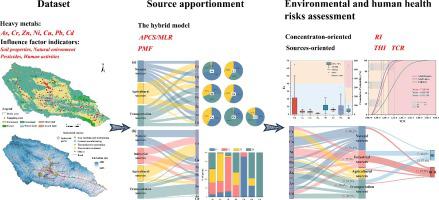当前位置:
X-MOL 学术
›
Ecol. Indic.
›
论文详情
Our official English website, www.x-mol.net, welcomes your feedback! (Note: you will need to create a separate account there.)
Source apportionment and risk assessment of soil heavy metals in the Huangshui River Basin using a hybrid model
Ecological Indicators ( IF 6.9 ) Pub Date : 2024-03-21 , DOI: 10.1016/j.ecolind.2024.111906 Wentao Zhou , Ruyue Yu , Fenghao Guo , Chongyang Shen , Yunjia Liu , Yuanfang Huang
Ecological Indicators ( IF 6.9 ) Pub Date : 2024-03-21 , DOI: 10.1016/j.ecolind.2024.111906 Wentao Zhou , Ruyue Yu , Fenghao Guo , Chongyang Shen , Yunjia Liu , Yuanfang Huang

|
Source apportionment and risk assessment of soil heavy metals (HMs) are essential for pollution control. However, inherent limitations in receptor models hinder accurate source apportionment, impacting outcomes of source-oriented risk assessment. A hybrid model was employed by combining two receptor models, absolute principal component score/multiple linear regression (APCS/MLR) and positive matrix factorization (PMF) models. Four primary pollution sources were identified, followed by an assessment of source-oriented environmental and human health risks in the Huangshui River Basin. Results revealed that Cr, Cd, and Ni average concentrations surpassed their background by 3.1, 2.1, and 1.9 times, respectively. Additionally, 54.29%, 13.34%, and 18.09% of I values for Cr, Cd, and Ni were classified as “moderately contamination” or higher. Natural sources significantly influence Cu (90.2%) and As (71.4%). Cr (63.4%) and Ni (77.9%) mainly originated from agriculture and industry, respectively. Transportation sources emerged as the primary contributors to Pb (59.6%), Zn (48.6%), and Cd (47.2%). The environmental risk level in this study area remained acceptable. Ecological risk was mainly attributed to industrial activities (46.6%) and transportation (37.6%), with Cd being the predominant metal responsible for this risk. Although the noncarcinogenic risk was negligible for all populations, the carcinogenic risk demands attention, particularly concerning children. Industrial sources (67.0%) and Ni were identified as the main contributors to the carcinogenic risk. This study represents an attempt to develop a hybrid model, providing an effective approach to combine models for the accurate apportionment of pollution sources and the reduction of risks.
中文翻译:

混合模型对湟水河流域土壤重金属的来源解析及风险评估
土壤重金属(HMs)的来源解析和风险评估对于污染控制至关重要。然而,受体模型的固有局限性阻碍了准确的来源分配,影响了面向来源的风险评估的结果。通过结合两种受体模型、绝对主成分评分/多元线性回归(APCS/MLR)和正矩阵分解(PMF)模型来采用混合模型。确定了4个主要污染源,并对湟水河流域源头环境和人体健康风险进行了评估。结果显示,Cr、Cd 和 Ni 的平均浓度分别超出其背景 3.1、2.1 和 1.9 倍。此外,Cr、Cd 和 Ni 的 I 值的 54.29%、13.34% 和 18.09% 被归类为“中度污染”或更高。自然资源显着影响铜 (90.2%) 和砷 (71.4%)。铬(63.4%)和镍(77.9%)分别主要来源于农业和工业。交通运输源成为铅 (59.6%)、锌 (48.6%) 和镉 (47.2%) 的主要来源。本研究区的环境风险水平仍然可以接受。生态风险主要归因于工业活动(46.6%)和交通运输(37.6%),其中镉是造成这种风险的主要金属。尽管非致癌风险对于所有人群来说可以忽略不计,但致癌风险需要引起注意,尤其是儿童。工业来源(67.0%)和镍被确定为致癌风险的主要贡献者。本研究尝试开发一种混合模型,为准确分配污染源和降低风险提供组合模型的有效方法。
更新日期:2024-03-21
中文翻译:

混合模型对湟水河流域土壤重金属的来源解析及风险评估
土壤重金属(HMs)的来源解析和风险评估对于污染控制至关重要。然而,受体模型的固有局限性阻碍了准确的来源分配,影响了面向来源的风险评估的结果。通过结合两种受体模型、绝对主成分评分/多元线性回归(APCS/MLR)和正矩阵分解(PMF)模型来采用混合模型。确定了4个主要污染源,并对湟水河流域源头环境和人体健康风险进行了评估。结果显示,Cr、Cd 和 Ni 的平均浓度分别超出其背景 3.1、2.1 和 1.9 倍。此外,Cr、Cd 和 Ni 的 I 值的 54.29%、13.34% 和 18.09% 被归类为“中度污染”或更高。自然资源显着影响铜 (90.2%) 和砷 (71.4%)。铬(63.4%)和镍(77.9%)分别主要来源于农业和工业。交通运输源成为铅 (59.6%)、锌 (48.6%) 和镉 (47.2%) 的主要来源。本研究区的环境风险水平仍然可以接受。生态风险主要归因于工业活动(46.6%)和交通运输(37.6%),其中镉是造成这种风险的主要金属。尽管非致癌风险对于所有人群来说可以忽略不计,但致癌风险需要引起注意,尤其是儿童。工业来源(67.0%)和镍被确定为致癌风险的主要贡献者。本研究尝试开发一种混合模型,为准确分配污染源和降低风险提供组合模型的有效方法。



























 京公网安备 11010802027423号
京公网安备 11010802027423号